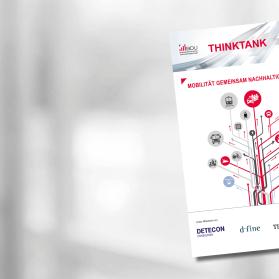What is driving the marketing of e-vehicles in China? What advantages does the collection of vehicle data offer customers, manufacturers, but also the state, and what challenges do international companies face? This interview sheds light on the background as well as strategic recommendations for action related to Real Time Monitoring (RTM) of BEVs and PHEVs in China.
Detecon: Mr. Gottwick, you have been involved in smart mobility, the development of connected car solutions and the associated data monetization for many years. At the moment, your focus is on Real Time Monitoring (RTM) of e-vehicles in China - what is behind this?
Mr Gottwick: To put it briefly: The Chinese government stringently subsidizes future topics that it considers important. One of these is the promotion of e-mobility. Real Time Monitoring (RTM) is a government-imposed program in China (based on recommended GB/T standards) with the aim of collecting and evaluating vehicle data related to e-mobility. Currently, if you want to buy and register an e-vehicle (BEV - Battery Electric Vehicle and PHEV - Plug-in Hybrid Electric Vehicle) from a local manufacturer in China, you as the end customer have to approve exactly this permanent collection of data vis-à-vis the vehicle dealer. RTM is currently still voluntary for international vehicle manufacturers, but local manufacturers in China are already required to sign this clause when selling vehicles in China. In my experience, however, many non-Chinese manufacturers already have this consent signed today - because it allows them to obtain the Purchase Tax Exemption (PTE) and other local incentives. Only if a dealer signs this contract clause with its end customers can the vehicle manufacturer or vehicle buyer be granted the PTE. This gives manufacturers the opportunity to offer e-vehicles in China at significantly more attractive conditions.
What data is collected as part of RTM and to whom is it provided?
During driving and charging, approximately 60 different data points are collected and transmitted every 10 seconds. In general, however, a distinction must be made between two types of data that play a role in RTM: One part relates to the approval process of a vehicle series (model data), another part to the operation of the individual vehicle (dynamic data). The model data includes information from the development and production systems, while the dynamic data includes, among other things, information on geo-position data, battery charge status and various other vehicle functions. The collected data is stored in the automaker's backend and transmitted to Chinese authorities as needed. In addition, written reports are prepared for the authorities in the event of unusual incidents; the authorities then match the contents of the reports with the previously transmitted data. The Chinese authorities cooperate primarily with research-related organizations and institutes such as the "Shanghai Electric Vehicle Public Data Collecting, Monitoring and Research Center". These institutes evaluate the collected data, develop the data analytics approaches and prepare them for the various authorities.
So customer and vehicle data is collected and made available to Chinese authorities and research institutes. In concrete terms, what added value do customers get from sharing their data?
We have to distinguish between two levels here: National and local. At the national level, customers generally have no choice. The added value here is that they are allowed to register the vehicle they want and operate it on public roads. In addition, they often receive the PTE outlined above. By monitoring the "New Electric Vehicles" (NEVs) and their manufacturers, the high safety standards are also controlled and implemented, which play an important role especially in large cities and thus benefit the customers and ultimately the entire population. In addition, the evaluated data can be used to better develop e-vehicles and to advance the planning of a user-friendly charging infrastructure. If customers also want to apply for the coveted green e-vehicle license plates in major cities such as Shanghai and Beijing, they will also have to share their data with local institutions there for further use. In return, they will receive a free license plate or the buyer will not have to take part in a draw for the license plates.
Why did the Chinese state create this program?
Two main reasons are repeatedly cited in this context: Safety and promotion of e-mobility. With regard to safety, the authorities want to ensure through the extensive collection of data that lessons are learned from minor accidents and that major incidents (such as fires in underground garages or in densely populated urban areas) can be avoided altogether. In addition, the data collected will be used to promote e-mobility in a targeted manner - for example, by expanding the charging infrastructure and building customized traffic routes. The extent to which the data will also be used to create personal user profiles is difficult to assess from today's perspective.
What impact will this have on international vehicle manufacturers?
The fact that the Chinese authorities have been collecting and evaluating data on an ongoing basis for some time now gives Chinese market players in particular a clear head start here, as there is close cooperation between local OEMs and the Chinese authorities in particular. This represents a major challenge for international OEMs, who must now catch up with this head start. To be able to act on an equal footing with the Chinese authorities, international OEMs need comprehensive data analytics capabilities in a timely manner. This is the only way they can keep a permanent eye on their own vehicle fleet. In the event of warnings from the RTM system, it must be possible to locate affected vehicles quickly and initiate appropriate measures without delay.
Finally, can you give us a little outlook: How should international OEMs deal with this situation and can they possibly also profit from this treasure trove of data?
As of today, more than two million vehicles with the RTM system in China are already constantly online, and this data is continuously and systematically evaluated by the Chinese authorities. Many international vehicle manufacturers must therefore now address the issue of how they themselves can store and evaluate the data already collected and available in China in a structured manner and, in particular, how they can derive tailored digital service offerings with clearly identifiable added customer value from this data.
Thank you very much for the interview.







